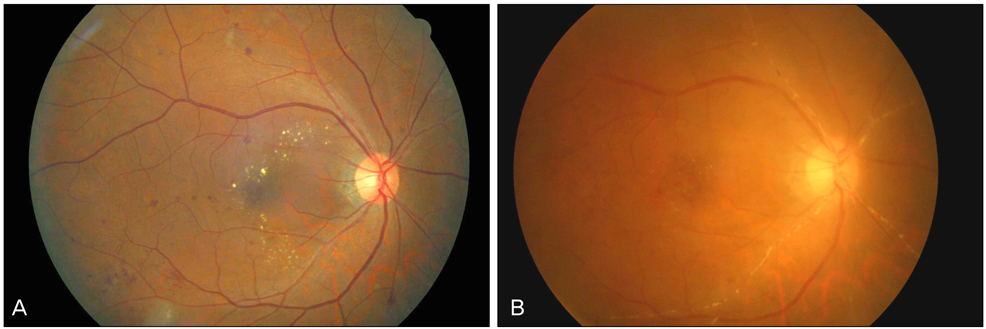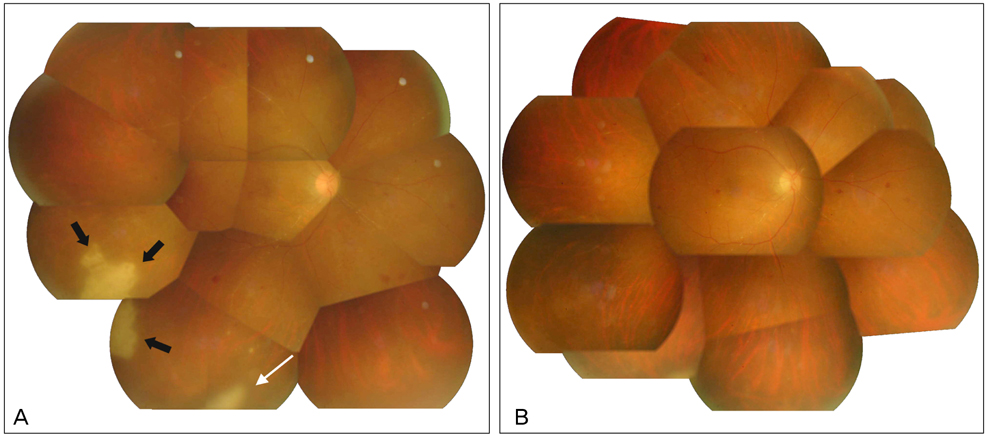Korean J Ophthalmol.
2011 Dec;25(6):451-454. 10.3341/kjo.2011.25.6.451.
Presumed Necrotizing Viral Retinitis after Intravitreal Triamcinolone Injection: Case Report
- Affiliations
-
- 1Department of Ophthalmology, Seoul National University Hospital, Seoul National University College of Medicine, Seoul, Korea.
- 2Department of Ophthalmology, Seoul National University Bundang Hospital, Seoul National University College of Medicine, Seongnam, Korea. sejoon1@hanmail.net
- KMID: 1031195
- DOI: http://doi.org/10.3341/kjo.2011.25.6.451
Abstract
- A 56-year-old man presented with anterior chamber inflammation, increased intraocular pressure, peripheral retinal infiltration, and generalized retinal arterial obstruction suggesting acute retinal necrosis five months after intravitreal triamcinolone acetonide injection (IVTA). He was treated with intravenous antiviral agents and aspirin. Shortly after treatment, retinal infiltrations were resolved, and partial recanalization of the obstructed vessel was observed. Viral retinitis may occur as an opportunistic infection following IVTA due to the local immune modulatory effect of the steroid; hence, close observation following IVTA is necessary.
Keyword
MeSH Terms
-
Antiviral Agents/therapeutic use
Aspirin/therapeutic use
Drug Therapy, Combination
Humans
Intravitreal Injections
Male
Middle Aged
Opportunistic Infections/*chemically induced/virology
Retinal Necrosis Syndrome, Acute/*chemically induced/virology
Triamcinolone Acetonide/administration & dosage/*adverse effects
Figure
Reference
-
1. Kramar M, Vu L, Whitson JT, He YG. The effect of intravitreal triamcinolone on intraocular pressure. Curr Med Res Opin. 2007. 23:1253–1258.2. Yilmaz T, Weaver CD, Gallagher MJ, et al. Intravitreal triamcinolone acetonide injection for treatment of refractory diabetic macular edema: a systematic review. Ophthalmology. 2009. 116:902–911.3. Shah AM, Oster SF, Freeman WR. Viral retinitis after intravitreal triamcinolone injection in patients with predisposing medical comorbidities. Am J Ophthalmol. 2010. 149:433–440.e1.4. Saidel MA, Berreen J, Margolis TP. Cytomegalovirus retinitis after intravitreous triamcinolone in an immunocompetent patient. Am J Ophthalmol. 2005. 140:1141–1143.5. Toh T, Borthwick JH. Acute retinal necrosis post intravitreal injection of triamcinolone acetonide. Clin Experiment Ophthalmol. 2006. 34:380–382.6. Aggermann T, Stolba U, Brunner S, Binder S. Endophthalmitis with retinal necrosis following intravitreal triamcinolone acetonide injection. Ophthalmologica. 2006. 220:131–133.7. Delyfer MN, Rougier MB, Hubschman JP, et al. Cytomegalovirus retinitis following intravitreal injection of triamcinolone: report of two cases. Acta Ophthalmol Scand. 2007. 85:681–683.8. Sekiryu T, Iida T, Kaneko H, Saito M. Cytomegalovirus retinitis after intravitreal triamcinolone acetonide in an immunocompetent patient. Jpn J Ophthalmol. 2008. 52:414–416.9. Park YS, Byeon SH. Cytomegalovirus retinitis after intravitreous triamcinolone injection in a patient with central retinal vein occlusion. Korean J Ophthalmol. 2008. 22:143–144.10. Tugal-Tutkun I, Araz B, Cagatay A. CMV retinitis after intravitreal triamcinolone acetonide injection in a patient with Behcet's uveitis. Int Ophthalmol. 2010. 30:591–593.11. Ufret-Vincenty RL, Singh RP, Lowder CY, Kaiser PK. Cytomegalovirus retinitis after fluocinolone acetonide (Retisert) implant. Am J Ophthalmol. 2007. 143:334–335.12. Moshfeghi DM, Kaiser PK, Scott IU, et al. Acute endophthalmitis following intravitreal triamcinolone acetonide injection. Am J Ophthalmol. 2003. 136:791–796.13. Beer PM, Bakri SJ, Singh RJ, et al. Intraocular concentration and pharmacokinetics of triamcinolone acetonide after a single intravitreal injection. Ophthalmology. 2003. 110:681–686.14. Cheng L, Banker AS, Martin M, et al. Triamcinolone acetonide concentration of aqueous humor after decanted 20-mg intravitreal injection. Ophthalmology. 2009. 116:1356–1359.
- Full Text Links
- Actions
-
Cited
- CITED
-
- Close
- Share
- Similar articles
-
- Cytomegalovirus Retinitis After Intravitreous Triamcinolone Injection in a Patient with Central Retinal Vein Occlusion
- Cytomegalovirus Retinitis after Intravitreal Bevacizumab Injection in an Immunocompetent Patient
- Treatment with Subtenon and Intravitreal Triamcinolone Acetonide for Cystoid Macular Edema after Cytomegalovirus Retinitis: A Case Report
- Presumed Noninfectious Endophthalmitis after Intravitreal Injection of Triamcinolone Acetonide
- Intravitreal and Additional Posterior Subtenon Triamcinolone Injection in Diabetic Macular Edema



